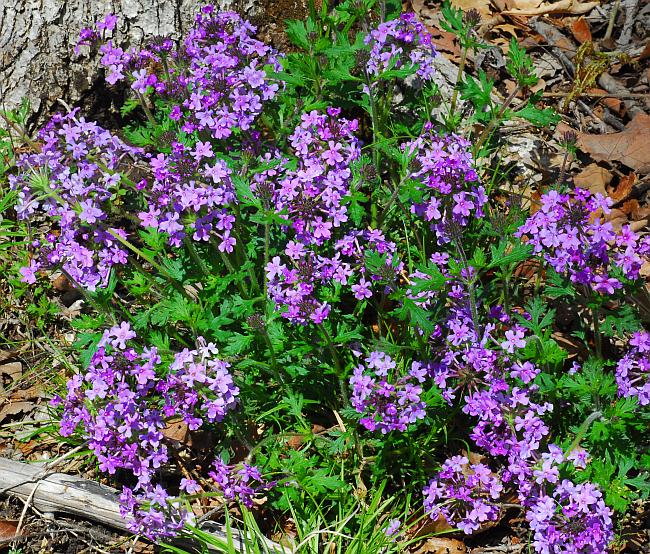Glandularia canadensis (L.) Small
Rose Verbena

Native
CC = 5
CW = 5
MOC = 70
© SRTurner
Glandularia canadensis (L.) SmallRose Verbena | |
 |
Native CC = 5 CW = 5 MOC = 70 |
© SRTurner |
|
Family - Verbenaceae Habit - Perennial forb with a woody caudex and fibrous roots Stems - Loosely ascending or creeping with ascending tips, to 60 cm, usually multiple from the base, 4-angled, sparsely to moderately pubescent with stiff, tapered, more or less spreading hairs.
Leaves - Opposite, petiolate, decussate. Petioles to 2 cm long, winged toward the tip, villous. Blades 2-9 cm long, variously ovate to oblong-ovate, triangular-ovate, or lanceolate in outline, tapered into the petiole basally, irregularly pinnatifid, most of the lobes extending half way to the midvein or less, the lobes variously triangular to oblong, the margins usually prominently few-toothed, flat, the surfaces sparsely to moderately pubescent with stiff, tapered, more or less appressed hairs, occasionally nearly glabrous.
Inflorescence - Terminal dense, flat-topped clusters, elongating to 5-15 cm spikes at fruiting. Flowers subtended by a single bract each, these mostly shorter than to about as long as the calyx, linear to narrowly triangular-lanceolate, to 9 mm long, 2 mm broad.
Flowers - Calyces 10-14 mm long, the lobes 4-6 mm long, hairy along the margins and pubescent with gland-tipped hairs on the outer surface. Corollas weakly zygomorphic, salverform, 18-30 mm long, the tube about 2 times as long as the calyx, glandular pubescent externally, villous internally and floccose near apex; the limb 10-20 mm in diameter, 5-lobed, pink to purple, glabrous. Stamens 4, didynamous, adnate near the middle of the corolla tube, included. Filaments white, to 1 mm long, glabrous. Anthers greenish. Style to 1.7 cm long, glabrous, greenish-white, included. Stigma unequally 2-lobed. Ovary green, glabrous, 4-lobed, 0.7 mm long.
Fruits - Usually 4 nutlets, these more or less cylindric, 3.0-3.5 mm long, usually rounded at the tip, somewhat asymmetrically concave at the base, the surface variously wrinkled, lined, and/or with a network of blunt ridges, sometimes also with small papillae, especially along the inner surface, grayish black to black.
Flowering - March - November. Habitat - Glades, forest openings, savannas, streambanks,ledges and tops of bluffs, fields, pastures, railroads, roadsides. Origin - Native to the U.S. Lookalikes - G. bipinnatifida, which is rare in Missouri. Other info. - This showy and attractive plant is scattered to common throughout most of Missouri. Its main U.S. range is in a band extending from Missouri and Kansas southward to the Gulf Coast, with more scattered locations elsewhere. It is easily recognized by the bright purple-pink flowers which are not quite radially symmetrical, and by the incised opposite leaves. The lookalike G. bipinnatifida, which is much less common in Missouri, has smaller flowers, bracts which exceed the calyx, and more deeply incised leaves. Photographs taken near Chilton Creek, Carter County, MO., 8-29-03 (DETenaglia); also at Shaw Nature Reserve, Franklin County, MO, 4-19-2007, Young Conservation Area, Jefferson County, MO, 4-24-2013 and 4-15-2020, Washington State Park, Washington County, MO, 4-16-2019, and St. Joe State Park, St. Francois County, MO, 4-26-2020 (SRTurner). |